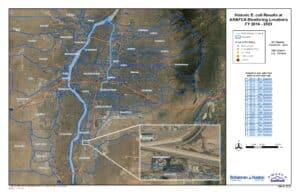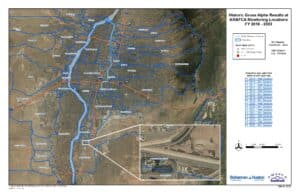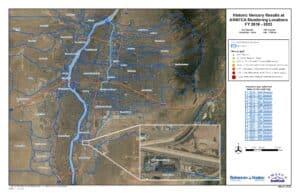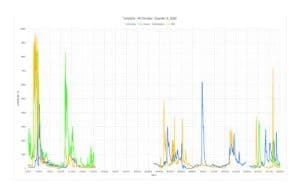Stormwater Runoff
Stormwater runoff is rain and snow melt that runs off surfaces like buildings, yards or hillsides, flowing down driveways, streets and channels, eventually reaching the Rio Grande. As stormwater runs over these surfaces, it picks up pollutants left behind by our activity.
Most pollutants end up in the river; stormwater is not treated like sewage.
According to the 1996 National Water Quality Inventory, stormwater runoff is a leading source of water pollution. Even before that study it was recognized that stormwater carried non-point sources of pollution.
Non-Point Source Pollution, like trash from your yard, is not usually intentional or concentrated, but it’s a problem, nonetheless. Unlike sewage or industrial wastes which are regulated at their source, non-point sources must be controlled largely by individual effort.
You are the solution to Stormwater Pollution!
Stormwater runoff is the most common cause of water pollution. Unlike pollution from industry or sewage treatment facilities, which is caused by discrete sources, stormwater pollution is caused by the daily activities of people everywhere. Rainwater and snowmelt run off streets, lawns, farms, and construction and industrial sites and pick up pet waste, fertilizers, dirt, pesticides, oil and grease and many other pollutants on the way to the Rio Grande. Unlike sewage, storm water receives almost no treatment before it is released into the Rio Grande.
Stormwater Quality
AMAFCA has a special interest in promoting stormwater quality, as all of the water in our arroyos and channels eventually reaches the Rio Grande River.
AMAFCA promotes stormwater quality as a member of the “Stormwater Quality Team.” See the Keep the Rio Grand website for more information about this program which features Rio the Duck (you may have seen or heard our ads). The “Scoop the Poop” campaign is also one of the Stormwater Quality Team’s Initiatives.
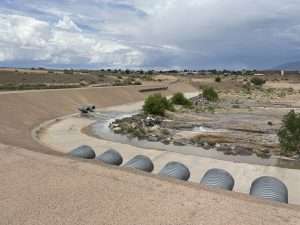
Black Arroyo Dam Water Quality Facility
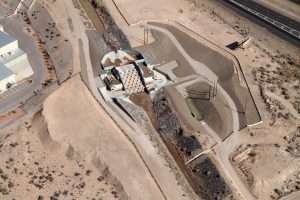
South Diversion Channel Baffle Chute Water Quality Structure
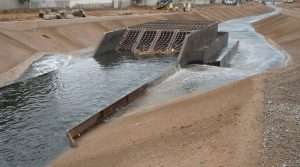
Hahn Arroyo Stormwater Quality Structure

Tijeras Arroyo Sediment Retention Structure
Stormwater Runoff Reports
Stormwater Monitoring Reports
FY23 Stormwater Monitoring Report, Download PDF
Rio Grande Water Quality Reports
AMAFCA maintains a broad collection of field instrumentation within their jurisdictional watershed to monitor surface water quality.
Surface water quality data is collected from four sites along the Rio Grande from US-550 to Isleta Pueblo via remote transmission.
The four sondes monitor and transmit several water quality parameter measurements near real-time. Data is then transmitted online at approximately 30-minute intervals.
The below reports provide the collected data for all three surface water quality parameters at all four sonde locations.
MS4 Compliance
The United States Environmental Protection Agency (EPA) regulates stormwater discharges under the Clean Water Act’s National Pollution Discharge Elimination System (NPDES) program. On November 16, 1990, the EPA published regulations (the ‘Phase I rule’) requiring NPDES permits for sources of stormwater runoff. The NPDES regulations cover discharges from municipal separate storm sewer systems (MS4s), certain industrial activities, and construction activities that disturb one acre or more of land.
The Phase I stormwater rule defines “municipal separate storm sewer” at 40 CFR 122.26(b)(8) to include any conveyance or system of conveyances that is owned or operated by a state or local government entity and is designed for collecting and conveying stormwater which is not part of a Publicly Owned Treatment Works (i.e., not a combined sewer). The Phase I MS4 regulations apply to MS4s serving populations of 100,000 or more.
The Stormwater Phase I Final Rule requires operators of regulated MS4s to obtain an NPDES permit and develop a stormwater management program designed to prevent harmful pollutants from being washed by stormwater runoff into bodies of water.
Albuquerque MS4 Compliance
AMAFCA, the City of Albuquerque, the New Mexico Department of Transportation, and the University of New Mexico are all co-permittees in the Albuquerque MS4 Permit. The permit was originally issued in 2003 and the newly updated MS4 permit was issued on March 1, 2012. The current permit covers a 5-year time frame and will expire on March 1, 2017.
On May 1, 2013, EPA published the draft Watershed-Based MS4 Permit for the Middle Rio Grande in the Federal Register. EPA also published a Fact Sheet on the draft Watershed-Based Permit to provide background information on the draft permit. Public comments were due July 1, 2013. AMAFCA comments were submitted to EPA Region 6 during the public comment period.
AMAFCA has updated (Rev. 7) of the Storm Water Management Program (SWMP) that includes the following six minimum control measures:
- Public Education and Outreach
- Public Participation/Involvement
- Illicit Discharge Detection and Elimination
- Construction Site Runoff Control
- Post-Construction Runoff Control
- Pollution Prevention/Good Housekeeping
As part of the SWMP, AMAFCA staff strives to inform the public about the importance of maintaining and improving the health of our local watershed. AMAFCA is a member of the Mid Rio Grande Stormwater Quality Team (MRGSQT) which has the sole mission of informing the public about stormwater quality issues. For more information about the MRGSQT, visit www.keeptheriogrand.org.
Middle Rio Grande Watershed-Based MS4 Permit
General Permit Requirements
Special Conditions
• Compliance with water quality standards Download PDF
• Discharges to impaired waters with and without TMDLs Download PDF
• Additional PCB assessment and study requirement for COA, AMAFCA, and Bernalillo County
• ESA requirements for addressing dissolved oxygen and sediment pollutant loads
Stormwater Management Program (SWMP)
• Minimum Control Measures (MCMs)
Monitoring and Assessment
SWMP Minimum Control Measures
• Construction site stormwater runoff control Download PDF
• Post-construction stormwater management in new development and redevelopment Download PDF
• Pollution prevention/good housekeeping
• Illicit discharges and improper disposal Download PDF
• Control of floatables discharges Download PDF
• Public education and outreach Download PDF
• Public involvement and participation Download PDF




